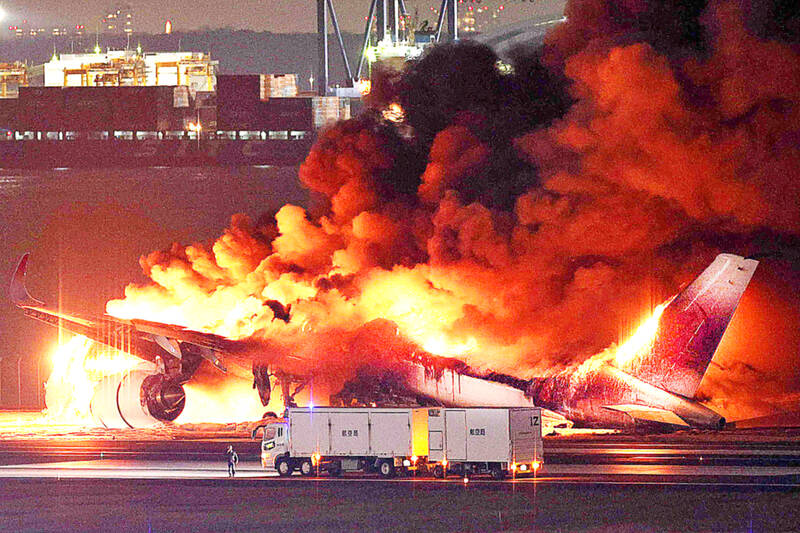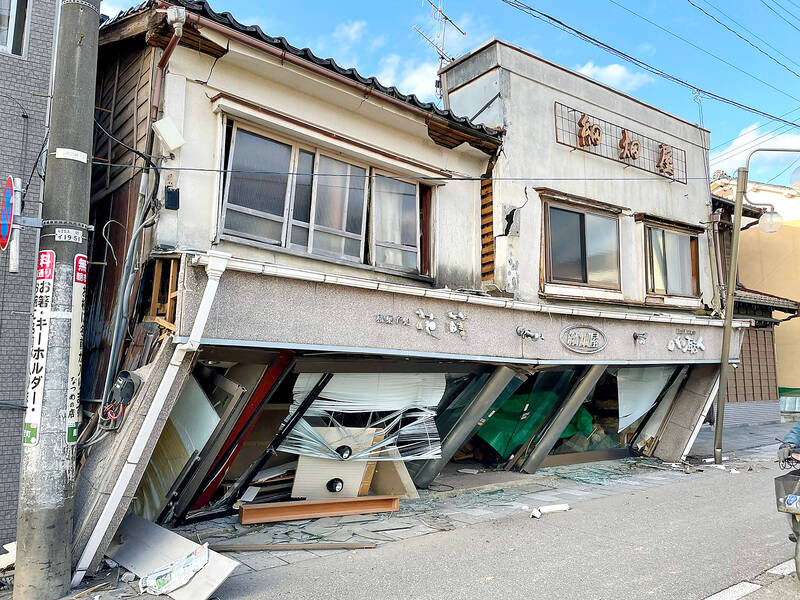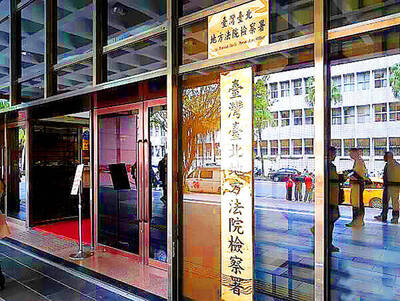A passenger plane yesterday collided with a Japanese coast guard aircraft and burst into flames on the runway of Tokyo’s Haneda airport, officials said.
National broadcaster NHK reported that all occupants of Japan Airlines Flight JAL-516, believed to total 379 people, got out safely before the plane was entirely engulfed in flames.
The Japan Coast Guard said that the pilot of its plane had escaped. NHK reported that the five other members of the crew had been found dead.

Photo: AFP
Local TV video showed a large eruption of fire and smoke from the side of the Japan Airlines plane as it taxied on a runway. The area around the wing then caught fire. Footage an hour later showed the plane fully on fire.
Japan Coast Guard spokesman Yoshinori Yanagishima confirmed the collision between the passenger plane and its flight MA-722, a Bombardier Dash-8.
Swede Anton Deibe, 17, who was a passenger on the Japan Airlines plane, told Swedish newspaper Aftonbladet that “the entire cabin was filled with smoke within a few minutes. We threw ourselves down on the floor. Then the emergency doors were opened and we threw ourselves at them.”

Photo: AFP / courtesy of X user @kanonstay
“The smoke in the cabin stung like hell. It was a hell. We have no idea where we are going so we just run out into the field. It was chaos,” added Deibe, who was traveling with his parents and sister.
Kyodo said the coast guard plane, which is based at Haneda, had been due to head to Niigata to deliver relief goods to residents affected by a deadly earthquake on Monday.
Meanwhile, Japanese rescuers yesterday were battling the clock and powerful aftershocks to find survivors of the earthquake that killed at least 48 people and caused widespread destruction.
The magnitude 7.5 quake that rattled Ishikawa Prefecture on the main island of Honshu triggered tsunami waves more than 1m high, caused a major fire and tore apart roads.
On the Noto Peninsula, the destruction included buildings damaged by fire, houses flattened, fishing boats sunk or washed ashore, and highways hit by landslides.
“I’m amazed the house is this broken and everyone in my family managed to come out of it unscathed,” said Akiko, standing outside her parents’ tilting home in the badly hit city of Wajima.
The way this year started “will be etched into my memory forever,” she said after what she called the “long and violent” earthquake.
“It was such a powerful jolt,” Tsugumasa Mihara, 73, said as he lined up with hundreds of others for water in the nearby town of Shika.
Local authorities put the death toll at 48, but the number was expected to rise as rescuers combed through the rubble.
“Very extensive damage has been confirmed, including numerous casualties, building collapses and fires,” Japanese Prime Minister Fumio Kishida said after a disaster response meeting. “We have to race against time to search for and rescue victims of the disaster.”
Aerial news footage showed the terrifying scale of a fire that ripped through the old market area of Wajima, where a seven-story commercial building also collapsed. Quake damage impaired rescue efforts to put out the blaze.
Almost 33,000 households were without power in the region, which saw temperatures touch freezing overnight, the local energy provider said. Many cities were without running water.
The quake was one of more than 210 to shake the region through yesterday evening.
Several jolts were felt early yesterday, including one measuring magnitude 5.6 that prompted NHK to switch to a special program.
“Please take deep breaths,” the presenter said, reminding viewers to check for fires in their kitchens.
Waves at least 1.2m high hit Wajima on Monday and a series of smaller tsunamis were reported elsewhere.
Warnings of much larger waves proved unfounded and yesterday Japan lifted all tsunami warnings.
Images on social media showed vehicles, houses and bridges in Ishikawa wobbling violently as terrified people cowered in shops and train stations. Houses collapsed and huge cracks appeared in roads, while others were hit by landslides.
A team of firefighters crawled under a collapsed commercial building in Wajima looking for survivors, television footage showed.
“Hang in there. Hang in there,” they shouted as they battled through piles of wooden beams with an electric saw.
The fire in Wajima engulfed as many as 200 structures, reports said, with people evacuated in the dark, some with blankets and others carrying babies.
Ishikawa Governor Hiroshi Hase wrote on social media that roads had been cut in widespread areas by landslides or cracking, while in the port of Suzu “multiple” vessels had capsized.
Suzu’s mayor called the damage in the city “catastrophic,” and said 1,000 houses had been completely destroyed there.

INVESTIGATION: The case is the latest instance of a DPP figure being implicated in an espionage network accused of allegedly leaking information to Chinese intelligence Democratic Progressive Party (DPP) member Ho Jen-chieh (何仁傑) was detained and held incommunicado yesterday on suspicion of spying for China during his tenure as assistant to then-minister of foreign affairs Joseph Wu (吳釗燮). The Taipei District Prosecutors’ Office said Ho was implicated during its investigation into alleged spying activities by former Presidential Office consultant Wu Shang-yu (吳尚雨). Prosecutors said there is reason to believe Ho breached the National Security Act (國家安全法) by leaking classified Ministry of Foreign Affairs information to Chinese intelligence. Following interrogation, prosecutors petitioned the Taipei District Court to detain Ho, citing concerns over potential collusion or tampering of evidence. The

‘FORM OF PROTEST’: The German Institute Taipei said it was ‘shocked’ to see Nazi symbolism used in connection with political aims as it condemned the incident Sung Chien-liang (宋建樑), who led efforts to recall Democratic Progressive Party (DPP) Legislator Lee Kun-cheng (李坤城), was released on bail of NT$80,000 yesterday amid an outcry over a Nazi armband he wore to questioning the night before. Sung arrived at the New Taipei City District Prosecutors’ Office for questioning in a recall petition forgery case on Tuesday night wearing a red armband bearing a swastika, carrying a copy of Adolf Hitler’s Mein Kampf and giving a Nazi salute. Sung left the building at 1:15am without the armband and apparently covering the book with a coat. This is a serious international scandal and Chinese

Seventy percent of middle and elementary schools now conduct English classes entirely in English, the Ministry of Education said, as it encourages schools nationwide to adopt this practice Minister of Education (MOE) Cheng Ying-yao (鄭英耀) is scheduled to present a report on the government’s bilingual education policy to the Legislative Yuan’s Education and Culture Committee today. The report would outline strategies aimed at expanding access to education, reducing regional disparities and improving talent cultivation. Implementation of bilingual education policies has varied across local governments, occasionally drawing public criticism. For example, some schools have required teachers of non-English subjects to pass English proficiency

TRADE: The premier pledged safeguards on ‘Made in Taiwan’ labeling, anti-dumping measures and stricter export controls to strengthen its position in trade talks Products labeled “made in Taiwan” must be genuinely made in Taiwan, Premier Cho Jung-tai (卓榮泰) said yesterday, vowing to enforce strict safeguards against “origin laundering” and initiate anti-dumping investigations to prevent China dumping its products in Taiwan. Cho made the remarks in a discussion session with representatives from industries in Kaohsiung. In response to the US government’s recent announcement of “reciprocal” tariffs on its trading partners, President William Lai (賴清德) and Cho last week began a series of consultations with industry leaders nationwide to gather feedback and address concerns. Taiwanese and US officials held a videoconference on Friday evening to discuss the